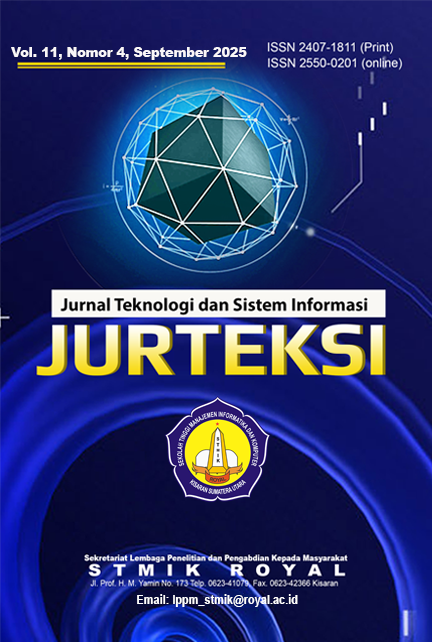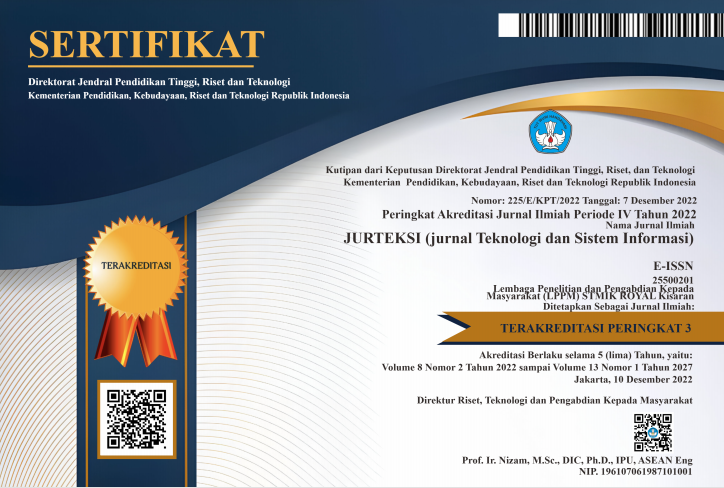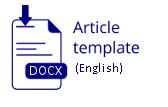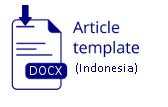DEVELOPMENT OF A BLOCKCHAIN-BASED DECENTRALISED APPLICATION WITH NFT FOR LAND REGISTRATION
Abstract
Abstract: Land registration in Indonesia often encounters challenges in transparency, data integrity, and centralized bureaucracy. Manual and semi-digital systems remain vulnerable to manipulation and delays. The National Land Agency has initiated digitalization, but several challenges remain, particularly in ensuring transparency, efficiency, and security of land ownership data. Blockchain technology offers a potential solution through its decentralized and immutable characteristics. This study adopted a design and development method consisting of system analysis, requirements identification, architecture design, implementation, and black-box testing. The developed decentralized application (DApp) integrates smart contracts, NFTs, and IPFS to manage land certificates. Core functions such as minting, transfer, splitting, and self-custody were implemented and successfully tested, with all scenarios producing expected results. The findings demonstrate that blockchain integration can enhance security, reduce duplication, and streamline land administration. The study contributes a functional prototype with practical implications for modernizing land registration in Indonesia while identifying scalability and regulatory adaptation as areas for further research.
Keywords: blockchain; decentralized application; land registration; NFT; smart contract.
References
A. S. A. Maharani, “85 Juta Bi-dang Tanah di Seluruh Indonesia Telah Bersertifikat,” Kompas.com.
S. Perdana Christa, “Sertifikat Ganda Pada Proyek Pembangunan Rumah Susun (Double Certificate Problem in Condominium Pro-ject),” Jurnal Legal Reasoning, vol. 1, no. 1, pp. 68–80, 2018.
R. A. Saputra, S. Silvana, and E. F. Marino, “Penyelesaian Sengketa Sertitikat Tanah Ganda Serta Ben-tuk Kepastian Hukumnya,” Jen-tera: Jurnal Hukum, vol. 4, no. 2, pp. 555–573, 2021.
U. Hadi, “Sertifikat Tanahnya Di-gandakan dan Dipakai Jaminan Utang, Warga Nganjuk Adukan Oknum Perangkat Desa ke Polisi,” Kompas.com.
R. A. Putra and A. Winanti, “Ur-gensi Dan Kendala Dalam Pen-erbitan Dokumen Sertifikat Tanah Elektronik Pasca Peraturan Men-teri ATR/BPN Nomor 3 Tahun 2023,” Jurnal Usm Law Review, vol. 7, no. 2, p. 835, 2024, doi: 10.26623/julr.v7i2.9178.
S. Nakamoto, “Bitcoin: A Peer-to-Peer Electronic Cash System,” Bitcoin, pp. 1–10, 2008, doi: 10.1108/TG-06-2020-0114.
H. Guo and X. Yu, “A survey on blockchain technology and its se-curity,” Blockchain: Research and Applications, vol. 3, no. 2, p. 100067, 2022, doi: 10.1016/j.bcra.2022.100067.
J. P. Nugraha, A. P. Kurniawan, I. D. Putri, R. K. Wicaksono, and T. Tarisa, “Penerapan Blockchain un-tuk Pencegahan Sertipikat Tanah Ganda di Kementerian Agraria dan Tata Ruang/Badan Pertanahan Nasional,” Widya Bhumi, vol. 2, no. 2, pp. 123–135, 2022, doi: 10.31292/wb.v2i2.43.
C. U. K. K. Negara, N. W. W. Pratiwi, and P. D. Maylinda, “Ur-gensi Sistem Pengamanan pada Sertifikat Tanah Digital,” Jurnal Hukum Lex Generalis, vol. 2, no. 9, pp. 832–855, 2021, doi: 10.56370/jhlg.v2i9.91.
Q. Wang, R. Li, Q. Wang, and S. Chen, “Non-Fungible Token (NFT): Overview, Evaluation, Op-portunities and Challenges,” 2021, [Online]. Available: http://arxiv.org/abs/2105.07447
K. S. Ilesanmi and T. O. Idowu, “Possibility of Land Ownership Transaction with Non-Fungible Token Technology: Minting Sur-vey Plan,” AgEcon Search, p. 18, 2007, [Online]. Available: file:///F:/Spec 2/Traffic Delay Model.pdf
V. V. Buterin, “Inteligentny Kon-trakt Nowej Generacji I Zdecen-tralizowana Platforma Aplikacji,” Whitepaper, no. January, pp. 1–36, 2014.
L. Ante, “Smart contracts on the blockchain – A bibliometric analy-sis and review,” Telematics and Informatics, vol. 57, no. October 2020, p. 101519, 2021, doi: 10.1016/j.tele.2020.101519.
P. Zheng, Z. Jiang, J. Wu, and Z. Zheng, “Blockchain-Based Decen-tralized Application: A Survey,” IEEE Open Journal of the Com-puter Society, vol. 4, no. August 2022, pp. 121–133, 2023, doi: 10.1109/OJCS.2023.3251854.
P. Verma, R. Srivastava, and S. Kumar, Blockchain technology: Applications and challenges, no. May. 2024. doi: 10.1201/9781003460367-1.













